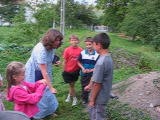 Following the traditional portion of the service, Rev. Sandor presented
greetings and gifts to the Bridgewater delegation, including a cloth for
our front table and a welcome mat for our front door. Both were, of course,
hand-made by the congregation from local materials. I presented
greetings on behalf of our delegation
and those who could not attend this time, and gifts -- including a hymnal,
a photograph of our church building, and an American flag -- that I later
found displayed prominently in the church. We had mixed feelings about presenting
the flag, especially in the context of a very unpopular war, but our hosts
in Transylvania were very happy to accept it from us, and did not associate
it at all with current politics.
Following the traditional portion of the service, Rev. Sandor presented
greetings and gifts to the Bridgewater delegation, including a cloth for
our front table and a welcome mat for our front door. Both were, of course,
hand-made by the congregation from local materials. I presented
greetings on behalf of our delegation
and those who could not attend this time, and gifts -- including a hymnal,
a photograph of our church building, and an American flag -- that I later
found displayed prominently in the church. We had mixed feelings about presenting
the flag, especially in the context of a very unpopular war, but our hosts
in Transylvania were very happy to accept it from us, and did not associate
it at all with current politics.| Chickens (tiny), ducks, and geese are so much
a part of the landscape that it is hardly possible to do them justice
with a snapshot (below). These are fowl with an attitude! It is perhaps
best appreciated by viewing Paloma's imitation by clicking on the small
photo to the left. |
The meal included a lot of delicious cabbage,
the preparation of which was another group effort.
CLICK (and turn head) TO ANIMATE Tunde, by the way, had not been as enthused about my photography the evening before, when I photographed her preparing potatoes. I did so because my friends had told me that Transylvania potatoes are a special treat, both because they are organic and unusually fresh and because they are prepared in a very special way. North Americans are so used to long-stored potatoes that most of us do not know that potatoes actually have a flavor! |
| The prior evening, Rev. Sandor had shown me
his "other office," which is like the Baldwin sisters' "recipe room" on
The Waltons . Here he has not one but two stills, which
are the source of some of the palenka we were to have in the village. When we first arrived at his house, Sandor said, "Would you like palenka, wine, or beer?" And then, "A good guest says, 'That order will be fine.'" Palenka was offered at every meal (including breakfast), between meals, and in the evening. Fortunately, I learned how to nurse it, because the home-brew version must be 160 proof or more. |

|
Pam and several of the Bridgewater kids found it
fun and challenging to teach rock, paper, scissors to a new audience.
CLICK TO ANIMATE |
Here I am enjoying a "champagne" toast with a new friend. Click on the image below to see how this special drink is made from local white wine and mineral water.. 
CLICK TO ANIMATE |
Some family members who had moved away from
the village came home to meet us. |
 This was a party, so some of the men of the church were singing. The man
at right in this photo so wanted me to stay and join them that I could barely
get out of his handshake when Sandor told me it was time to go home. Much
later, I realized that this is the Haranglab equivalent of the
Male Bonding Band
. The room was not bright enough for good video, but the sounds of this very
traditional singing is a great memory from the evening.
This was a party, so some of the men of the church were singing. The man
at right in this photo so wanted me to stay and join them that I could barely
get out of his handshake when Sandor told me it was time to go home. Much
later, I realized that this is the Haranglab equivalent of the
Male Bonding Band
. The room was not bright enough for good video, but the sounds of this very
traditional singing is a great memory from the evening.